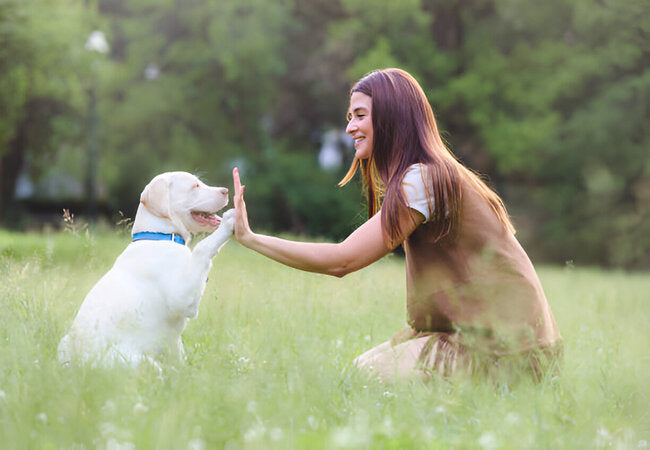The Power of Praise: Encouraging Good Behavior in Dogs—Vet Guide 2025 🐾

In this article
The Power of Praise: Encouraging Good Behavior in Dogs—Vet Guide 2025 🐾
By Dr. Duncan Houston BVSc
🐶 In 2025, veterinarians and trainers agree: praise, when used correctly, becomes a powerful positive reinforcer—especially when paired with treats or petting. Studies confirm dogs learn faster, feel less stress, and bond more deeply through thoughtful verbal and physical encouragement. Let’s explore how to wield praise effectively to encourage good habits, reduce unwanted behaviors, and strengthen your connection with your pup.
1. Why Praise Works (Especially When Paired) 🎯
In training science, praise is considered a secondary reinforcer—it’s learned value gained through association with primary rewards like treats or play. Pairing “Good dog!” with a treat consistently helps your dog internalize praise as valuable, which eventually lets praise stand alone as a reward.
One study showed dogs trained with praise and petting learned faster and experienced less stress than those trained with treats only.
2. Pairing Praise with Real Rewards
- Choose high-value rewards: Food, toy, or petting should follow praise.
- Immediate timing: Praise the instant the desired behavior happens, then reward.
- Mark and reward: Use a consistent marker (“Yes!” or clicker), followed by praise and a treat.
3. Phasing Out Treats—Fading with Praise
Once behavior is reliable, move into intermittent reinforcement—gradually replace treats with praise and occasional reward. This builds confidence in praise while maintaining motivation with surprises.
From crafting a new cue to achieving fluency in real-world distractions, timing and consistency are key. Fade treats based on your dog’s progress.
4. When Praise Works Best—and When It Doesn’t
- Best for: Tricks, obedience, calm settling, recall—especially after pairing.
- Less effective alone for: Fearful or high-drive scenarios—treats and petting often remain stronger reinforcers.
- Effective with varied reinforcement: Rotate treats, praise, play, sniff breaks, and environmental rewards to maintain motivation.
5. Reddit Wisdom: Real-World Praise Tips
> “Verbal praise has to be taught… use the word ‘yes’ as our praise.” > “Praise is a secondary reinforcer… if every time you give treats you also say ‘aww good dog!!’ pretty soon you’ll notice your puppy start to prick her ears up when she hears that praise.”
6. Choosing the Right Praise Style
- Use a clear marker: “Yes” or click then praise.
- Enthusiastic tone: High energy builds engagement.
- Physical affection: Petting or gentle pats enhance the effect.
- Avoid negative praise: Don’t overuse praise when correcting—a neutral tone is better.
7. Avoid These Pitfalls
- Don’t deliver praise without a follow-up reward early in training.
- Avoid letting treats become bribes—mark before the dog acts.
- Watch your dog’s motivators—if they don’t enjoy petting, it won’t reinforce behavior.
- Rotate reinforcers to prevent extinction or boredom.
8. Scaling Praise in Daily Life
- Teach simple cues—sit, down, come—with consistent praise pairing.
- During walks, mark calm or leash-walking, reward intermittently.
- Use praise during crate settling or grooming—paired initially with treats.
- Phase treats after confidence builds, and reinforce with praise for maintenance.
9. When to Use Praise Alone vs. Other Rewards
After pairing, praise alone suits calm, indoor behaviors. For high-energy or distracting environments, resume occasional treats to maintain attention. For complex performance or sports, alternate treats, praise, and play.
10. Deepening Your Bond with Praise
Praise does more than train—it builds trust. Learned praise helps your dog understand your happiness and strengthens the emotional connection.
Training now engages their mind and heart—rewarding good behavior becomes part of your relationship, not just a command-response routine.
Vet‑Backed Praise Action Plan 2025 📋
- 🔹 Choose a marker word (“Yes!”) and pair with treats/petting consistently
- 🔹 Immediately follow desired behavior with a marker, praise, and a reward
- 🔹 Fade treats gradually using variable reinforcement
- 🔹 Use intermittent treats plus praise to maintain behavior in real life
- 🔹 Rotate rewards—food, play, praise, environment—to deepen engagement
FAQs 💬
• Can I train with praise only?
Start with pairing—praise alone works well after repeated association with rewards. Don’t skip the pairing stage.
• What if my dog doesn’t care about pets?
Use praise or treats instead—find what motivates them. Some dogs prefer food, others enjoy play or praise more.
• Does praise lose value over time?
Not if you occasionally pair with a primary reinforcer. Intermittent treats and praise help maintain its value.
• Is praise effective for reactive dogs?
Praise alone isn’t enough—use it along with management, desensitization, and sometimes medical support. Consult a behaviorist for structured help.
Conclusion ❤️
In 2025, praise isn’t just fluff—it’s a foundational tool in your dog's training. Paired with treats or petting, it fosters faster learning, reduced stress, and stronger bonds. By pairing, timing, fading, and diversifying rewards, you empower positive behavior reinforcement that lasts, deepening your connection well beyond obedience. 🐕✨
Need help crafting a praise and reward plan? Visit AskAVet.com or download the Ask A Vet app for 24/7 expert guidance and training tools.






